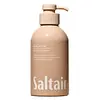What's inside
What's inside
 Key Ingredients
Key Ingredients

 Benefits
Benefits

 Concerns
Concerns

 Ingredients Side-by-side
Ingredients Side-by-side

Water
Skin ConditioningCocamidopropyl Betaine
CleansingSodium C16 Olefin Sulfonate
EmulsifyingTheobroma Grandiflorum Seed Butter
Skin ConditioningPlumeria Acutifolia Flower Extract
Skin ConditioningAleurites Moluccanus Seed Oil
Skin ConditioningNiacinamide
SmoothingAscorbyl Glucoside
AntioxidantCandida Bombicola/Glucose/Methyl Rapeseedate Ferment
AntimicrobialSodium PCA
HumectantOlea Europaea Fruit Oil
MaskingHelianthus Annuus Seed Oil
EmollientMagnesium PCA
HumectantArgania Spinosa Kernel Oil
EmollientHydrolyzed Gardenia Florida Extract
AntioxidantZinc PCA
HumectantLithospermum Erythrorhizon Root Extract
Skin ConditioningGlycyrrhiza Uralensis Root Extract
Skin ConditioningAngelica Gigas Root Extract
Skin ConditioningSodium Hyaluronate
HumectantManganese PCA
HumectantGardenia Jasminoides Fruit Extract
Cosmetic ColorantPhenoxyethanol
PreservativeSodium Cocoyl Isethionate
CleansingSodium Benzoate
MaskingPEG-150 Distearate
EmulsifyingCitric Acid
BufferingTetrasodium Glutamate Diacetate
Maltodextrin
AbsorbentParfum
MaskingBenzyl Salicylate
PerfumingHexyl Cinnamal
PerfumingLinalool
PerfumingWater, Cocamidopropyl Betaine, Sodium C16 Olefin Sulfonate, Theobroma Grandiflorum Seed Butter, Plumeria Acutifolia Flower Extract, Aleurites Moluccanus Seed Oil, Niacinamide, Ascorbyl Glucoside, Candida Bombicola/Glucose/Methyl Rapeseedate Ferment, Sodium PCA, Olea Europaea Fruit Oil, Helianthus Annuus Seed Oil, Magnesium PCA, Argania Spinosa Kernel Oil, Hydrolyzed Gardenia Florida Extract, Zinc PCA, Lithospermum Erythrorhizon Root Extract, Glycyrrhiza Uralensis Root Extract, Angelica Gigas Root Extract, Sodium Hyaluronate, Manganese PCA, Gardenia Jasminoides Fruit Extract, Phenoxyethanol, Sodium Cocoyl Isethionate, Sodium Benzoate, PEG-150 Distearate, Citric Acid, Tetrasodium Glutamate Diacetate, Maltodextrin, Parfum, Benzyl Salicylate, Hexyl Cinnamal, Linalool
 Reviews
Reviews

Ingredients Explained
These ingredients are found in both products.
Ingredients higher up in an ingredient list are typically present in a larger amount.
Citric Acid is an alpha hydroxy acid (AHA) naturally found in citrus fruits like oranges, lemons, and limes.
Like other AHAs, citric acid can exfoliate skin by breaking down the bonds that hold dead skin cells together. This helps reveal smoother and brighter skin underneath.
However, this exfoliating effect only happens at high concentrations (20%) which can be hard to find in cosmetic products.
Due to this, citric acid is usually included in small amounts as a pH adjuster. This helps keep products slightly more acidic and compatible with skin's natural pH.
In skincare formulas, citric acid can:
While it can provide some skin benefits, research shows lactic acid and glycolic acid are generally more effective and less irritating exfoliants.
Most citric acid used in skincare today is made by fermenting sugars (usually from molasses). This synthetic version is identical to the natural citrus form but easier to stabilize and use in formulations.
Read more about some other popular AHA's here:
Learn more about Citric AcidParfum is a catch-all term for an ingredient or more that is used to give a scent to products.
Also called "fragrance", this ingredient can be a blend of hundreds of chemicals or plant oils. This means every product with "fragrance" or "parfum" in the ingredients list is a different mixture.
For instance, Habanolide is a proprietary trade name for a specific aroma chemical. When used as a fragrance ingredient in cosmetics, most aroma chemicals fall under the broad labeling category of “FRAGRANCE” or “PARFUM” according to EU and US regulations.
The term 'parfum' or 'fragrance' is not regulated in many countries. In many cases, it is up to the brand to define this term.
For instance, many brands choose to label themselves as "fragrance-free" because they are not using synthetic fragrances. However, their products may still contain ingredients such as essential oils that are considered a fragrance by INCI standards.
One example is Calendula flower extract. Calendula is an essential oil that still imparts a scent or 'fragrance'.
Depending on the blend, the ingredients in the mixture can cause allergies and sensitivities on the skin. Some ingredients that are known EU allergens include linalool and citronellol.
Parfum can also be used to mask or cover an unpleasant scent.
The bottom line is: not all fragrances/parfum/ingredients are created equally. If you are worried about fragrances, we recommend taking a closer look at an ingredient. And of course, we always recommend speaking with a professional.
Learn more about ParfumSodium Benzoate is a preservative. It's used in both cosmetic and food products to inhibit the growth of mold and bacteria. It is typically produced synthetically.
Both the US FDA and EU Health Committee have approved the use of sodium benzoate. In the US, levels of 0.1% (of the total product) are allowed.
Sodium benzoate works as a preservative by inhibiting the growth of bacteria inside of cells. It prevents the cell from fermenting a type of sugar using an enzyme called phosphofructokinase.
It is the salt of benzoic acid. Foods containing sodium benzoate include soda, salad dressings, condiments, fruit juices, wines, and snack foods.
Studies for using ascorbic acid and sodium benzoate in cosmetics are lacking, especially in skincare routines with multiple steps.
We always recommend speaking with a professional, such as a dermatologist, if you have any concerns.
Learn more about Sodium BenzoateSodium cocoyl isethionate is a natural ingredient from coconut oil. It is an ultra gentle cleanser that gives a nice foam without drying the skin or impacting the skin barrier.
The amount of foam created depends on the amount of sodium cocoyl isethionate used in the product.
This ingredient also helps improve the spreadability of a product.
Learn more about Sodium Cocoyl Isethionate